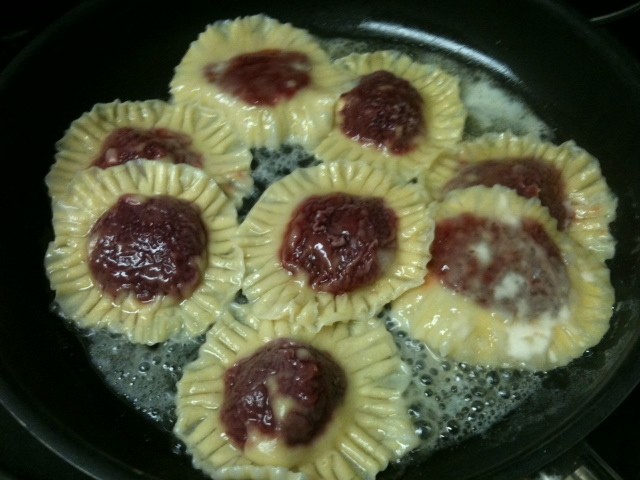
Beets get little love. Ask people to name a dish with beets, and the first thing 90% of people will say is borscht, which in the United States is an bland, smooth, violently red-purple potage, as though a toddler with fingerpaints tried to make vichyssoise even more insipid than it already is. (Borscht in Russia is a chunky, filling, satisfying soup–who knows why it got emasculated as it crossed the ocean.)
Ask Midwestern and Southern transplants what to cook with beets, and it will boil down to one sweet-sour answer: pickle them.
Ask the patrons of coastal California-cuisine restaurants what happens to beets, and 90% of them will talk about a stacked salad of goat cheese and roasted beets, possibly with some frou-frou arugula so it could properly be called a salad. Better–and in the case of some salads with finger lime, pretty damn good.
The Italians–the northern Italians, the so-far-north-it's-practically-Austria Italians–have a better answer: put them into pasta. Casunziei (cah-ZOON-z'yay) are a speciality of Cortina d'Ampezzo, in the Dolomites (Italian Alps) north of Venice. They're essentially beet ravioli, a sweet-savory filling stuffed into fresh pasta. Like all ravioli, they're a pain to make, but the payoff is big.
]
Fresh Pasta
Ingredients:
1 1/2 cups all-purpose flour (replace 1/2 cup with White Lily flour if you have it)
3 egg yolks
1 Tbsp. extra-virgin olive oil
Warm water
Preparation:
1. In a food processor, combine the flour, egg yolks and oil and pulse until thoroughly integrated.
2. Set the processor on low speed and pour water slowly through the chute until the pasta forms a ball.
3. Knead for 5 minutes on an unfloured counter until it becomes a little bit shiny, a lot more smooth, and a lot less sticky.
4. Divide in quarters, roll into balls, wrap in cling film and let sit on the counter for 30-45 minutes.
5. Put each piece through a pasta machine (the one that attaches to a KitchenAid is fine), starting on setting 1, all the way through setting 5.
6. Set on a heavily floured table, or hang over a floured peg, otherwise it will stick.
If you don't have the machinery, you can still make the dough. Just stir the egg and oil together in a bowl, then mix by hand. You can roll out the dough by hand as well, but you will need a significant amount of flour to keep it from sticking. It should be the thickness of a dime when you are done, and by rolling it out with a wooden pin, the sauce will cling slightly better.
Filling
Ingredients:
1 pound beets
6 oz. potatoes (little Yukon Golds work fine here)
1 tsp. salt
3/4 tsp. cinnamon
1/2 tsp. nutmeg
1 Tbsp. flour
Extra-virgin olive oil
Preparation:
1. Wash but do not peel the beets and potatoes; rub them with olive oil and prick them once with a knife.
2. Roast in a pan in a 400ºF oven for 45 minutes or so, until a knife easily pierces them.
3. Let cool.
4. If you have a food mill, you don't need to peel; if you are using a food processor or doing it by hand, peel the beets and potatoes.
5a. If using a food mill, put the beets and potatoes through it, then add the salt, cinnamon, nutmeg and flour to the bowl and mix well.
5b. If using a food processor, put the beets, potatoes, salt, cinnamon, nutmeg and flour through the food processor at once until it forms a paste.
5c. If doing it by hand, mash the beets and potatoes on a flat surface (covered with parchment paper, otherwise the beets will stain the surface). Try to avoid lumps. Place in a bowl and mix in the salt, cinnamon, nutmeg and flour.
6. Taste. It should be strongly flavored but not overwhelming. Adjust seasoning as required.
Assembly
Ingredients:
1 recipe pasta, as above
1 recipe filling, as above
1 egg, beaten with 1 tsp. of water
Preparation:
1. Cut rounds out of the pasta with a biscuit cutter (or a knife and narrow-mouth glass).
2. Put 3/4 tsp. or so of filling off-center in each round, away from the edges. It shouldn't take up more than about 1/3 of the pasta round.
3. Brush half of the edge of each round with egg and fold over the un-egged side.
4. Press gently from the filling out so that there are no air pockets, then seal the pasta by pressing the un-egged side firmly onto the egged side.
5. Pleat the pasta so that it won't come undone, and lay in one layer on a tray covered in cling film.
As an alternative, you can put more filling in the center of each round, brush the entire edge with egg, and then use more rounds of pasta to create large, round casunziei. If you do this, make sure to pleat carefully, or use a fork to mash it shut. (This will result in very rustic, homemade-looking casunziei.)
You can re-roll the pasta through the machine, starting at setting #1, after letting it sit covered for 15 minutes to relax the gluten. It won't be as perfect as the first round, but it will still taste fine.
Final steps
Ingredients:
Casunziei, as above
1/2 stick (4 Tbsp.) unsalted butter
1 tsp. poppy seeds
Parmigiano cheese, grated
Preparation:
1. Boil the casunziei in a large quantity of salted water for 2-3 minutes (they should float to the top, unless you've made enormous casunziei).
2. Melt the butter in a skillet, then transfer the boiled casunziei to the skillet and sauté.
3. Sprinkle the poppy seeds over the top and garnish with Parmigiano.
4. Serve immediately.

